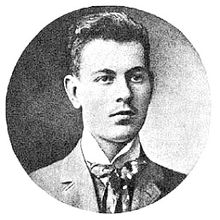| This article includes a list of general references, but it lacks sufficient corresponding inline citations. Please help to improve this article by introducing more precise citations. (July 2023) (Learn how and when to remove this message) |
| Kārlis Zāle | |
|---|---|
 | |
| Born | 28 October 1888 Mažeikiai, Russian Empire |
| Died | 19 February 1942(1942-02-19) (aged 53) Inčukalns, Reichskomissariat Ostland |
| Nationality | Latvian |
| Known for | Sculpture |
| Notable work | Freedom Monument |
Kārlis Zāle (28 October 1888 – 19 February 1942) was a Latvian sculptor.
Zāle was born in Mažeikiai, but grew up in Liepāja. After training in Russia at the Kazan Art School under Alexander Matveyev and in Germany, he returned to Riga in 1923, where he both worked in sculpture and taught it. He is best known for his monumental sculptures, including the massive main gates at Brothers' Cemetery and the Freedom Monument in Riga.
Gallery
-
 Freedom Monument, Riga
Freedom Monument, Riga
-
 Detail, Monument to the Soldiers of the 6th Infantry Regiment, Sudrabkalniņš (Silver Hill), Riga
Detail, Monument to the Soldiers of the 6th Infantry Regiment, Sudrabkalniņš (Silver Hill), Riga
-
 Main gate, Brothers' Cemetery (Riga)
Main gate, Brothers' Cemetery (Riga)
-
 Liberty atop the Freedom Monument
Liberty atop the Freedom Monument
References
- "Renovated Charles Lawn «Mother Latvian» Mets" Latvian Public Media. Retrieved 2017-02-07.
- Slava, Laima. "Kārlis Zāle". Latvian Cultural Canon. Archived from the original on 1 June 2016. Retrieved 22 January 2015.
- Apsitis, V., 1982 (3ed edn, 1993). Latvian Art in 1915–1940 (comp. I. Burane). Stockholm: Latvian State Academy of Arts.
External links
- Classic.Culture.lv: Short Biography
- "Brīvības Piemineklis" (Freedom Monument), published by the Freedom Monument Committee, 1935 (in Latvian, partially translated)
This article about a Latvian sculptor is a stub. You can help Misplaced Pages by expanding it. |